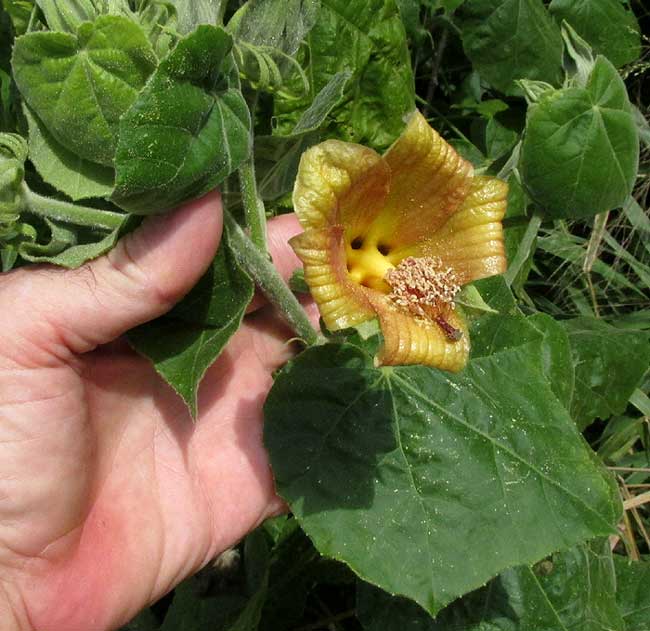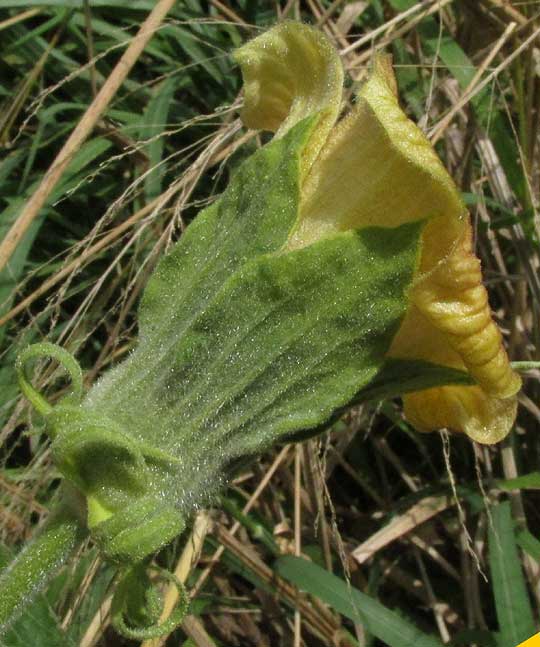Excerpts from Jim Conrad's
Naturalist Newsletter

from the December 14, 2014 Newsletter issued from Río Lagartos, on the Yucatan Peninsula's northern coast (~N21.60°, ~W88.16°), Yucatán state, MÉXICO
CONGO MAHOE
At the weedy edge of a small patch of scrubby woods in the savanna south of Río Lagartos, pretty, apple-size, bowl-shaped, off-yellow flowers adorned a hairy-leafed tree, as shown above.
The flower astonished me. Obviously, with its many stamens united at their bases into a cylinder around the ovary's style -- forming what's called a 'staminal column' -- the tree is a member of the big Hibiscus Family. However, I'd never seen an hibiscus-type flower with its staminal column tilted so decidedly downward. A closer look at that amazing plunging column is provided below:

Not only is the column tilted, but its stamens cluster on the column's top side. The style's branched, purplish stigmatic area actually seems to rest on the corolla's lower surface. Also, notice the deep nectar pits at the column's base where hummingbirds are clearly invited to dip their beaks. Abundant whitish pollen splattered across the corolla's interior evidence recent visits by pollinators. A glance at the back of the flower shows that the fuzzy calyx also is a bit unusual, its acutely pointed sepals topping a broad calyx tube, and the calyx with its five sepals subtended by a circle of slender bracts, shown below:

Several flowers had matured to the point that their corollas had shriveled and dropped off leaving behind a tawny-colored, furry ovary developing within the cup of the leathery calyx, as shown below:

To identify this exotic-looking species I reviewed every member of the Hibiscus Family listed for the Yucatan, except for Hibiscus itself -- which I reckoned it couldn't possibly be because of that crazily tilted staminal column -- and found no matches. Maybe it was an invasive species or even something new.
But, the short story is that finally in desperation I looked among the Hibiscuses and... there it was. It's HIBISCUS CLYPEATUS, with the unlikely name of Congo Mahoe. James Macfadyen in his Flora of Jamaica suggests that the name was invented by African slaves who found it similar to something they'd left back home.
Still, this is an all-American native tree, and a fine one, endemic to southeastern Mexico, Belize, Guatemala and the Caribbean area.
Though with us the Congo Mahoe tends to emerge from dense, woods-edge thickets as if scared to show itself, when planted and cared for it makes a handsome tree with pretty, interesting flowers. Europe's Gardening.EU website says of the Congo Mahoe that "... during the summer it assumes a red colouring; the adult species are large in size and reach 17 m in height." 17m is 56 feet. Nothing is said of its cold hardiness.
As with many woody members of the Hibiscus family, the tree's inner bark is toughly fibrous. The fibers have been used traditionally for making cord, whips and lashes.